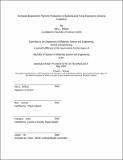Increased biopolymer pigment production in bacteria and fungi exposed to ionizing radiation
Author(s)
Wilson, Sara L., S.B. Massachusetts Institute of Technology.
Download1262873713-MIT.pdf (895.3Kb)
Other Contributors
Massachusetts Institute of Technology. Department of Materials Science and Engineering.
Terms of use
Metadata
Show full item recordAbstract
A major concern for manned space missions is ionizing radiation, which is known to pose both acute and chronic risks to many organisms. It is critical to expand strategies for radiation protection, including utilizing new materials and fabrication methods designed to support and augment health and wellbeing. The Mediated Matter Group in the Media Lab is researching the application of pigments for biocompatible radioprotection. These pigments' properties--including both UV and ionizing radiation absorption--lend themselves to interesting potential applications in biomedicine and biotechnology¹,². Some bacteria and fungi respond to ionizing radiation with enhanced growth and pigment production, and they have been found in a variety of extreme and high radiation environments³. This thesis is an exploration of the potential of pigments, like melanins and carotenoids, to protect from and react to ionizing radiation in the context of space. Certain bacteria and fungi show a remarkable ability to persist, and even thrive, in high-radiation environments⁴. The bacteria of interest in this study are Bacillus subtilis and Rhizobium etli; the fungi of interest are Aspergillus niger, Neurospora crassa, and Xanthophyllomyces dendrorhous. These organisms form biopolymer pigments, including melanins and carotenoids, which may potentially have an important role in the radioresistance of the organisms⁵. For this reason, the Mediated Matter Group is conducting research both simulating and in space environments to understand the impact of radiation on biological systems and their adaptive strategies. In this work, we examine the growth and behavior of several species of bacteria and fungi while exposed to radiation to determine mechanisms by which they may adapt to these harsh conditions.
Description
Thesis: S.B., Massachusetts Institute of Technology, Department of Materials Science and Engineering, May, 2020 Cataloged from the official PDF version of thesis. "May 2020." Includes bibliographical references (pages 29-35).
Date issued
2020Department
Massachusetts Institute of Technology. Department of Materials Science and EngineeringPublisher
Massachusetts Institute of Technology
Keywords
Materials Science and Engineering.